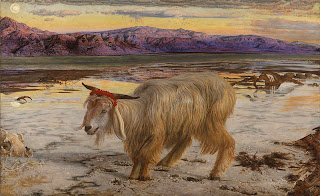Although the aim of the
group was to stay secret, one every painting they did they left the initials
PRB.
William Holman Hunt painted a Painting which he named the scapegoat where he depicts a scene taken from the book of leviticus. He paints a goat with it’s horns wrapped in red cloth representing the sins of humanity on the day of atonement.
William Holman Hunt painted a Painting which he named the scapegoat where he depicts a scene taken from the book of leviticus. He paints a goat with it’s horns wrapped in red cloth representing the sins of humanity on the day of atonement.
John Everett Millais’s
“Christ in the house of his parents” is a painting which at the time received a
lot of negative critique as it was found to be controversial. Infact it was one
of the paintings which pushed the PRB movement from obscurity and into the lime
light. Making way to the debate on the “Realism” in art.
Dante's Dream at the Time of the Death of Beatrice was painted in the
1871 by Dante
Gabriel Rossetti. It was inspired by a poem written by Dante Alighieri name “La
Vita Nuova” literally meaning “The New
Life”.The painting shows the beatrice
deing and Dante overlooking. An angel is seen in the middle
The works of the
Pre-Raphaelites was met with a lot
of opposition to their Stress on the emotional and personal aspects of
religion, archaizing
compositions, the realism, the lack of
shadows, flat depiction of forms as well as the coloration that they achieved
by painting on a wet white ground. The movement however had several important
supporters . Notably was the writer John
Ruskin (1819–1900), a passionate supporter of painting from nature and a
leading exponent of the Gothic Revival in England. Ruskin particularly admired
the Pre-Raphaelites' significant innovations to English landscape painting:
their dedication to working en plein air,
strict botanical accuracy, and minute detail. Whilst he did not initially admire the brotherhood's
goals, he later wrote that they "may, as they gain experience, lay in our
England the foundation of a school of art nobler than the world has seen for
three hundred years." Experience, in fact, served less to unify the
Brotherhood and promote its founding ideals than to foster individual
identities and styles. By the early 1850s, the Brotherhood dissolved, though
several of the artists remained close friends and collaborators for the rest of
their careers.
Bibliography
Pre-Raphaelite Brotherhood - Wikipedia, the free encyclopedia. 2013. Pre-Raphaelite Brotherhood - Wikipedia, the free encyclopedia. [ONLINE] Available at: http://en.wikipedia.org/wiki/Pre-Raphaelite_Brotherhood. [Accessed 09 April 2013].
National Gallery of Art – Pre-Raphaelites: Victorian Art and Design, 1848-1900. 2013. National Gallery of Art – Pre-Raphaelites: Victorian Art and Design, 1848-1900. [ONLINE] Available at:http://www.nga.gov/exhibitions/preraphaelites.shtm. [Accessed 09 April 2013].
The Pre-Raphaelites | Thematic Essay | Heilbrunn Timeline of Art History | The Metropolitan Museum of Art. 2013. The Pre-Raphaelites | Thematic Essay | Heilbrunn Timeline of Art History | The Metropolitan Museum of Art. [ONLINE] Available at: http://www.metmuseum.org/toah/hd/praf/hd_praf.htm. [Accessed 09 April 2013].
What is Pre-Raphaelite Art? | Pre-Raphaelite Sisterhood. 2013. What is Pre-Raphaelite Art? | Pre-Raphaelite Sisterhood. [ONLINE] Available at:http://preraphaelitesisterhood.com/what-is-pre-raphaelite-art/. [Accessed 09 April 2013]



No comments:
Post a Comment